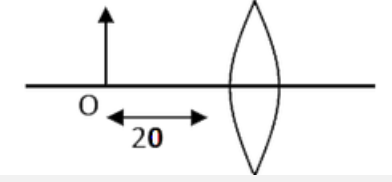The distance between an object and a divergent lens is m times the focal length of the lens. The linear magnification produced by the lens is
m
1m
m+1
1m+1
The correct Answer is:D
To solve the problem of finding the linear magnification produced by a divergent lens when the object distance is m times the focal length, we can follow these steps:
Step 1: Understand the relationship between object distance (u), image distance (v), and focal length (f)
For a lens, the lens formula is given by:
1v−1u=1f
where:
- u is the object distance (negative for a real object),
- v is the image distance (positive for a virtual image in the case of a divergent lens),
- f is the focal length (negative for a divergent lens).
Step 2: Define the object distance in terms of the focal length
Given that the object distance u is m times the focal length f:
u=−mf
(Note: The negative sign indicates that the object is placed on the same side as the incoming light for a lens.)
Step 3: Substitute u into the lens formula
Substituting u into the lens formula:
1v−1−mf=1f
This simplifies to:
1v+1mf=1f
Step 4: Rearranging the equation
Rearranging gives:
1v=1f−1mf
1v=m−1mf
Step 5: Find the image distance v
Taking the reciprocal to find v:
v=mfm−1
Step 6: Calculate the magnification
The linear magnification M produced by the lens is given by:
M=vu
Substituting the values of v and u:
M=mfm−1−mf
This simplifies to:
M=−1m−1
Final Answer
Thus, the linear magnification produced by the lens is:
M=−1m−1
For a lens, the lens formula is given by:
1v−1u=1f
where:
- u is the object distance (negative for a real object),
- v is the image distance (positive for a virtual image in the case of a divergent lens),
- f is the focal length (negative for a divergent lens).
Given that the object distance u is m times the focal length f:
u=−mf
(Note: The negative sign indicates that the object is placed on the same side as the incoming light for a lens.)
Substituting u into the lens formula:
1v−1−mf=1f
This simplifies to:
1v+1mf=1f
Rearranging gives:
1v=1f−1mf
1v=m−1mf
Taking the reciprocal to find v:
v=mfm−1
The linear magnification M produced by the lens is given by:
M=vu
Substituting the values of v and u:
M=mfm−1−mf
This simplifies to:
M=−1m−1
Thus, the linear magnification produced by the lens is:
M=−1m−1
Topper's Solved these Questions
- BOOK - DC PANDEY ENGLISHCHAPTER - RAY OPTICSEXERCISE - medical entrance special format question23videos
RAY OPTICS
- BOOK - DC PANDEY ENGLISHCHAPTER - RAY OPTICSEXERCISE - Medical entrance gallary76videos
RAY OPTICS
- BOOK - DC PANDEY ENGLISHCHAPTER - RAY OPTICSEXERCISE - Checkpoint 9.710videos
RAY OPTICS
- BOOK - DC PANDEY ENGLISHCHAPTER - NUCLEIEXERCISE - C MADICAL ENTRANCES GALLERY46videos
NUCLEI
- BOOK - DC PANDEY ENGLISHCHAPTER - REFLECTION OF LIGHTEXERCISE - Subjective9videos
REFLECTION OF LIGHT
Similar Questions
A convex lens of focal length f is placed somewhere in between an object and a screen. The distance between the object and the screen is x. If the numerical value of the magnification produced by the lens is m, then the focal lnegth oof the lens is .
View SolutionAn extended real object of size 2cm is palced perpendicular to the principle axis of a converging lens of focal length 20cm. The distance between the object and the lens is 30cm
(i) Find the laterial magnification produced by the lens.
(ii) Find the height of the image.View SolutionIn a displacement method the distance between the object and the screen is 70 cm and the focal length of the lens is 16 cm, find the separations of the magnified and diminished image position of the lens.
View SolutionCalculate focal length of given lens if the magnification is −0.5.
 View Solution
View SolutionA convex lens is placed between an object and a screen which are at a fixed distance apart for one position of the lens. The magnification of the image obtained on the screen is m1. When the lens is moved by a distance d the magnification of the image obtained on the same screen m2, Find the focal length of the lens.
View SolutionMagnification by a lens of an object at distance 10 cm from it is -2. now a seconnd lens is placed exactly at the same positon where first was kept, without changing the distance between object and lens. The magnification by this second lens is -3.
What is the focal length of the combination when both lenses are in contact ?View SolutionA convex lens is placed some where between an object and a screen which are separated by 48 cm. If the numerical value of magnification produced by the lens is 3, what is the focal length of lens?
View SolutionA convex lens of focal length 20 cm and a concave lens of focal length 10 cm are placed 20 cm apart. In between them an object placed at distance x from the convex lens.
What will be the linear magnification produced convex lens and concave lens individually ?View SolutionDistance of an object from a concave lens of focal length 20 cm is 40 cm. Then linear magnification of the image
View SolutionIf the focal length of objective lens is increased then magnifying power of
View Solution
